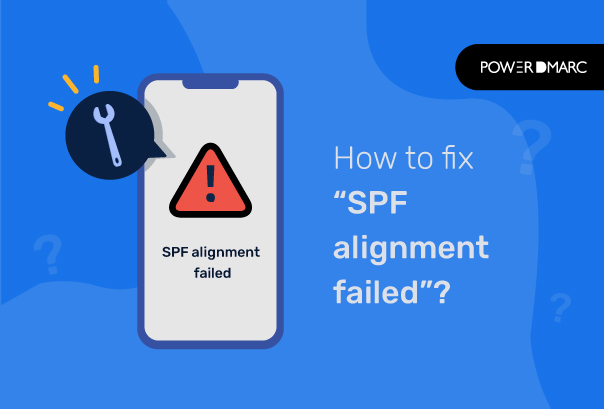If your DMARC aggregate report says “SPF alignment failed” let’s discuss what it means to have your SPF in alignment and how you can resolve this issue. To protect your domain and online identity from fraudsters trying to pass off as you, you need to set up DMARC for your email domains. DMARC works by the cumulative email authentication efforts of SPF and DKIM protocols. Subsequently, DMARC users also benefit from receiving reports on delivery issues, authentication, and alignment failures for their emails. Learn more about what is DMARC here.
What is SPF alignment?
An email message is made up of several different headers. Each header contains information about certain attributes of an email message, including the date sent, where it was sent from, and who it was sent to. SPF deals with two types of email headers:
- The <From:> header
- The Return-Path header
When the domain in the From: header and the domain in the return-path header is a match for an email, SPF alignment passes for that email. However, when the two are not a match, it consequently fails. SPF alignment is an important criterion that decides whether an email message is legitimate or fake.
Shown above is an example where the From: header is in alignment (exactly matches) with the Return-path header (Mail From), hence SPF alignment would pass for this email.
Why Does SPF alignment fail?
Case 1: Your SPF alignment mode is set to strict
While the default SPF alignment mode is relaxed, setting a strict SPF alignment mode can lead to alignment failures if the return-path domain happens to be a subdomain of the root organizational domain, while the From: header incorporates the organizational domain. This is because for SPF to align in a strict mode, the domains in the two headers must be an exact match. However, SPF alignment will pass if the two domains share the same top-level domain for relaxed alignment.
Shown above is an example of a mail that shares the same top-level domain but the domain name isn’t an exact match ( the Mail From domain is a subdomain of the organizational domain company.com). In this case, if your SPF alignment mode is set to “relaxed”, your email will pass SPF alignment, however for a strict mode, it will fail the same.
Case 2: Your domain has been spoofed
A very common reason for SPF alignment failures is domain spoofing. This is the phenomenon when a cybercriminal takes over your identity by forging your domain name or address to send emails to your receivers. While the From: domain still bears your identity, the Return-path header displays the original identity of the spoofer. If you have SPF authentication in place for your forged domain, the email inevitably fails alignment on the receiver’s side.
Fixing “SPF alignment failed”
To fix SPF alignment failures you can:
- Set your alignment mode to “relaxed” instead of “strict”
- Configure DMARC for your domain, atop SPF and DKIM, so that even if your email fails SPF header alignment and passes DKIM alignment, it passes DMARC and gets delivered to your recipient
Our DMARC report analyzer can help you gain 100% DMARC compliance on your outgoing emails and prevent spoofing attempts or alignment failures due to protocol misconfigurations. Enjoy a safer and more reliable authentication experience by taking your free DMARC trial today!
- Fix SPF Permerror: Overcome SPF Too Many DNS Lookups Limit - April 26, 2024
- How to Publish a DMARC Record in 3 Steps? - April 2, 2024
- Why is DMARC failing? Fix DMARC Failure in 2024 - April 2, 2024
